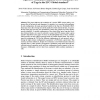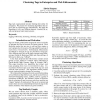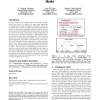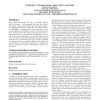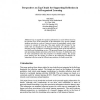IWRT
2008
14 years 1 months ago
2008
Abstract. This paper addresses the evaluation of a passive RFID system under a continuous flow of tag arrivals and departures, for instance, in a conveyor belt installation. In suc...
ICWSM
2008
14 years 1 months ago
2008
Tags lack organizational structure limiting their utility for navigation. We present two clustering algorithms that improve this by organizing tags automatically. We apply the alg...
ICWSM
2008
14 years 1 months ago
2008
This paper presents an analysis of the correlation of annotated information unit (textual) tags and geographical identification metadata geotags. In this paper, to make it possibl...
CIKM
2008
Springer
14 years 1 months ago
2008
Springer
In social media, such as blogs, since the content naturally evolves over time, it is hard or in many cases impossible to organize the content for effective navigation. Thus, one c...
HT
2010
ACM
14 years 1 months ago
2010
ACM
1 Tags are an important information source in Web 2.0. They can be used to describe users’ topic preferences as well as the content of items to make personalized recommendations....
ICPR
2010
IEEE
14 years 2 months ago
2010
IEEE
Social tagging is an increasingly popular way to describe and classify documents on the web. However, the quality of the tags varies considerably since the tags are authored freel...
ICADL
2007
Springer
14 years 3 months ago
2007
Springer
With an exponential growth of Weblogs (or blogs), many blog directories have appeared to help users to locate topical blogs. As tags are commonly used to describe blogs, we study t...
GROUP
2007
ACM
14 years 3 months ago
2007
ACM
Many online communities use tags
ADC
2009
Springer
14 years 3 months ago
2009
Springer
Radio Frequency Identification (RFID) technology uses radio-frequency waves to automatically identify people or objects. A large volume of data, resulting from the fast capturing ...
39
Voted
GI
2009
Springer
14 years 4 months ago
2009
Springer
: Tags are popular for organising information in social software based on the personal views of the participants on the information. Tags provide valuable attention meta-data on a ...
